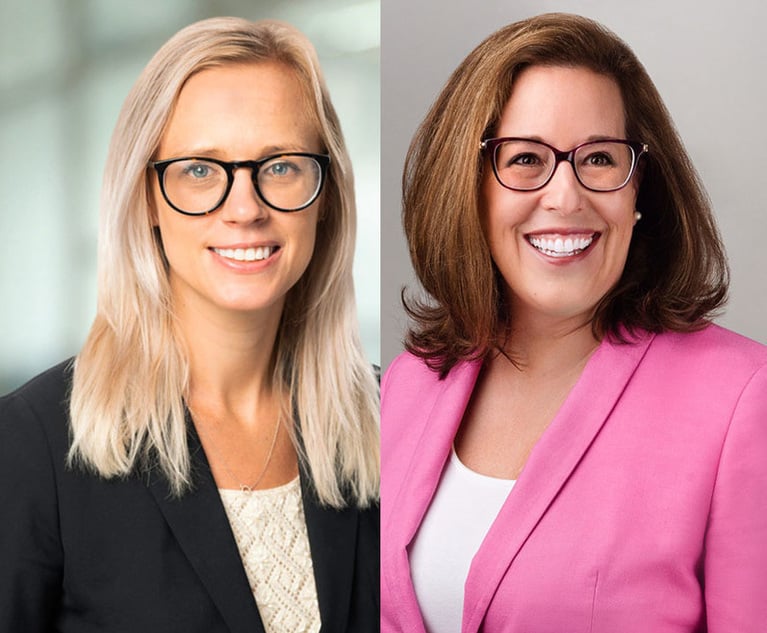 Timothy J. Horstmann and Erica M. Koser of McNees Wallace & Nurick.
Timothy J. Horstmann and Erica M. Koser of McNees Wallace & Nurick.What Is Material? The SEC Says You Have to Decide
An “obligated person” means any person, including the issuer, that supports the payment of all or part of the obligations on municipal securities to be publicly offered for sale.
December 06, 2018 at 01:55 PM
7 minute read
After months of deliberation, on Aug. 20, the U.S. Securities and Exchange Commission (the SEC) announced its final approval of new amendments (the 2018 Amendments) to Rule 15c2-12, 17 C.F.R. Section 240.15c2-12 (herein, Rule 15c2-12 or the rule). Rule 15c2-12 requires dealers, when underwriting certain types of municipal securities, to ensure that “obligated persons” enter into a written commitment (called a continuing disclosure agreement, or CDA) to make periodic disclosure filings to the Municipal Securities Rulemaking Board (the MSRB). An “obligated person” means any person, including the issuer, that supports the payment of all or part of the obligations on municipal securities to be publicly offered for sale.
The 2018 Amendments created two new categories of events which must be included in the CDA. The two new events added to Rule 15c2-12 are as follows:
- Incurrence of a financial obligation of the obligated person, if material, or agreement to covenants, events of default, remedies, priority rights, or other similar terms of a financial obligation of the obligated person, any of which affect security holders, if material (Event 15).
- Default, event of acceleration, termination event, modification of terms, or other similar events under the terms of a financial obligation of the obligated person, any of which reflect financial difficulties (Event 16).
The 2018 Amendments define “financial obligation” to include a debt obligation; (derivative instrument entered into in connection with or pledged as security or a source of payment for, an existing or planned debt obligation; or guarantee of either one. The term, narrower than first proposed, is intended to focus on debt, debt-like or debt-related obligations of obligated persons. This term does not include municipal securities as to which a final official statement has been provided to the MSRB consistent with the Rule.
The compliance date for the 2018 Amendments is Feb. 27, 2019, exactly 180 days after the amendments were first published in the Federal Register (the compliance date). Any CDA entered into on or after this date must include both Event 15 and Event 16. Event 15 and Event 16 do not apply retroactively to CDA's in existence prior to the compliance date.
As issuers, underwriters, attorneys and other industry professionals prepare for the compliance date, many are left wondering, “what is material?” Under any CDA entered into after the compliance date, obligated persons must disclose all material financial obligations incurred on or after the date on which such CDA was entered.
The question of “materiality,” although not an easy one, is certainly not a new one. Over 40 years ago, the U.S. Supreme Court, in TSC Industries v. Northway, 426 U.S. 438 (1976), addressed the subject of materiality in the context of securities fraud, finding that a fact is material if there is “a substantial likelihood that a reasonable shareholder would consider it important in deciding how to vote … Put another way, there must be a substantial likelihood that the disclosure of the omitted fact would have been viewed by the reasonable investor as having significantly altered the 'total mix' of information made available.”
More than a decade later, in Basic vs. Levinson, 485 U.S. 224 (1988), the Supreme Court reiterated the TSC Industries standard of materiality, stating that something is material if there is “a substantial likelihood that the disclosure of the omitted fact would have been viewed by the reasonable investor as having significantly altered the 'total mix' of information made available.” In this case, the court ultimately concluded that materiality “will depend at any given time upon a balancing of both the indicated probability that the event will occur and the anticipated magnitude of the event in light of the totality of the entity's activity.”
Using these seminal cases as their guidepost, the SEC has adopted a similar definition of materiality in the context of financial statements, providing that “a matter is 'material' if there is a substantial likelihood that a reasonable person would consider it important … The omission or misstatement of an item … is material if, in the light of the surrounding circumstances, the magnitude of the item is such that it is probable that the judgment of a reasonable person relying upon the report would have been changed or influenced by the inclusion or correction of the item,” see “U.S. Securities and Exchange Commission Staff Accounting Bulletin No. 99 – Materiality,” 17 C.F.R. Section 211, Sbpt. B (Aug. 12, 1999). According to the SEC, judgments of materiality “can properly be made only by those who have all the facts.”
Consistent with its past approach, the SEC has declined to offer detailed guidance on how determinations of materiality should be made in evaluating compliance with the 2018 Amendments to the rule. Citing diversity among issuers, differences in issue types, and variety in payment sources, the SEC noted in the preamble to the 2018 Amendments that a specific formula for determining materiality would be inappropriate and would unnecessarily restrict the type of flexibility needed in making these decisions. Instead, the SEC has said that it is up to you, the issuers, other obligated persons and industry professionals, to assess your disclosure obligations and decide what is material and when disclosure is necessary.
Fortunately, the SEC has provided some guideposts to assist issuers and other obligated persons in making these determinations. In the preamble to the 2018 Amendments, the SEC stated that each issuer and obligated person must determine its disclosure obligations in the context of the specific facts and circumstances. Materiality determinations under Event 15 should be based on whether the information would be important to the total mix of information made available to a reasonable investor. In making this determination, issuers and other obligated persons should use the same analysis already being used in the preparation of the offering documents.
Circumstances and factors of potential relevance, according to the SEC, include the size of the overall balance sheet, the size of existing obligations, the size of the overall bond portfolio, covenants, events of defaults, remedies, the source of security pledged for repayment of the financial obligation and also the rights associated with such a pledge.
The SEC acknowledges that issuers and obligated persons will incur costs in making materiality determinations. As such, the SEC has proposed several ways to mitigate these costs. First, issuers and obligated persons should begin the process of assessing whether a particular obligation should be disclosed in advance of its incurrence. Second, in addition to staying abreast of developing industry practices, issuers and other obligated persons should amend their existing disclosure policies and procedures to include policies on how financial obligations will be evaluated for materiality. Additionally, industry experts have also advised that issuers and other obligated persons should maintain a record of the analysis that was undertaken in making the materiality decision. If an event is ultimately determined to be material, an event notice must be filed within 10 business days of the date the “financial obligation” is incurred.
Timothy J. Horstmann and Erica M. Koser are public finance attorneys with the law firm of McNees Wallace & Nurick and practice in the firm's public finance group. Horstmann and Koser regularly advise issuers and other obligated persons regarding their continuing disclosure obligations to ensure compliance with Rule 15c2-12. Contact them at [email protected], and [email protected].
This content has been archived. It is available through our partners, LexisNexis® and Bloomberg Law.
To view this content, please continue to their sites.
Not a Lexis Subscriber?
Subscribe Now
Not a Bloomberg Law Subscriber?
Subscribe Now
NOT FOR REPRINT
© 2025 ALM Global, LLC, All Rights Reserved. Request academic re-use from www.copyright.com. All other uses, submit a request to [email protected]. For more information visit Asset & Logo Licensing.
You Might Like
View All
Pittsburgh Judge Rules Loan Company's Online Arbitration Agreement Unenforceable
3 minute read
De-Mystifying the Ethics of the Attorney Transition Process, Part 1


Risk Mitigation: Employee Engagement Results in Fewer Lawsuits (and Other Benefits)
5 minute readTrending Stories
- 1To Speed Criminal Discovery, NY Bill Proposes Police-to-Prosecutor Pipeline For Records
- 2Merchan Rejects Trump's Bid to Delay Manhattan Sentencing
- 3High-Low Settlement Agreement 'Does Not Alone Establish Bias:' State High Court Affirms $20M Med Mal Verdict
- 4NYAG Preparing to Withdraw From Defense of Four Correction Officers' Federal Lawsuits
- 52 Judges: Meet the New Chief Justice and the GC Who Just Rose to the Bench
Who Got The Work
Michael G. Bongiorno, Andrew Scott Dulberg and Elizabeth E. Driscoll from Wilmer Cutler Pickering Hale and Dorr have stepped in to represent Symbotic Inc., an A.I.-enabled technology platform that focuses on increasing supply chain efficiency, and other defendants in a pending shareholder derivative lawsuit. The case, filed Oct. 2 in Massachusetts District Court by the Brown Law Firm on behalf of Stephen Austen, accuses certain officers and directors of misleading investors in regard to Symbotic's potential for margin growth by failing to disclose that the company was not equipped to timely deploy its systems or manage expenses through project delays. The case, assigned to U.S. District Judge Nathaniel M. Gorton, is 1:24-cv-12522, Austen v. Cohen et al.
Who Got The Work
Edmund Polubinski and Marie Killmond of Davis Polk & Wardwell have entered appearances for data platform software development company MongoDB and other defendants in a pending shareholder derivative lawsuit. The action, filed Oct. 7 in New York Southern District Court by the Brown Law Firm, accuses the company's directors and/or officers of falsely expressing confidence in the company’s restructuring of its sales incentive plan and downplaying the severity of decreases in its upfront commitments. The case is 1:24-cv-07594, Roy v. Ittycheria et al.
Who Got The Work
Amy O. Bruchs and Kurt F. Ellison of Michael Best & Friedrich have entered appearances for Epic Systems Corp. in a pending employment discrimination lawsuit. The suit was filed Sept. 7 in Wisconsin Western District Court by Levine Eisberner LLC and Siri & Glimstad on behalf of a project manager who claims that he was wrongfully terminated after applying for a religious exemption to the defendant's COVID-19 vaccine mandate. The case, assigned to U.S. Magistrate Judge Anita Marie Boor, is 3:24-cv-00630, Secker, Nathan v. Epic Systems Corporation.
Who Got The Work
David X. Sullivan, Thomas J. Finn and Gregory A. Hall from McCarter & English have entered appearances for Sunrun Installation Services in a pending civil rights lawsuit. The complaint was filed Sept. 4 in Connecticut District Court by attorney Robert M. Berke on behalf of former employee George Edward Steins, who was arrested and charged with employing an unregistered home improvement salesperson. The complaint alleges that had Sunrun informed the Connecticut Department of Consumer Protection that the plaintiff's employment had ended in 2017 and that he no longer held Sunrun's home improvement contractor license, he would not have been hit with charges, which were dismissed in May 2024. The case, assigned to U.S. District Judge Jeffrey A. Meyer, is 3:24-cv-01423, Steins v. Sunrun, Inc. et al.
Who Got The Work
Greenberg Traurig shareholder Joshua L. Raskin has entered an appearance for boohoo.com UK Ltd. in a pending patent infringement lawsuit. The suit, filed Sept. 3 in Texas Eastern District Court by Rozier Hardt McDonough on behalf of Alto Dynamics, asserts five patents related to an online shopping platform. The case, assigned to U.S. District Judge Rodney Gilstrap, is 2:24-cv-00719, Alto Dynamics, LLC v. boohoo.com UK Limited.
Featured Firms
Law Offices of Gary Martin Hays & Associates, P.C.
(470) 294-1674
Law Offices of Mark E. Salomone
(857) 444-6468
Smith & Hassler
(713) 739-1250





